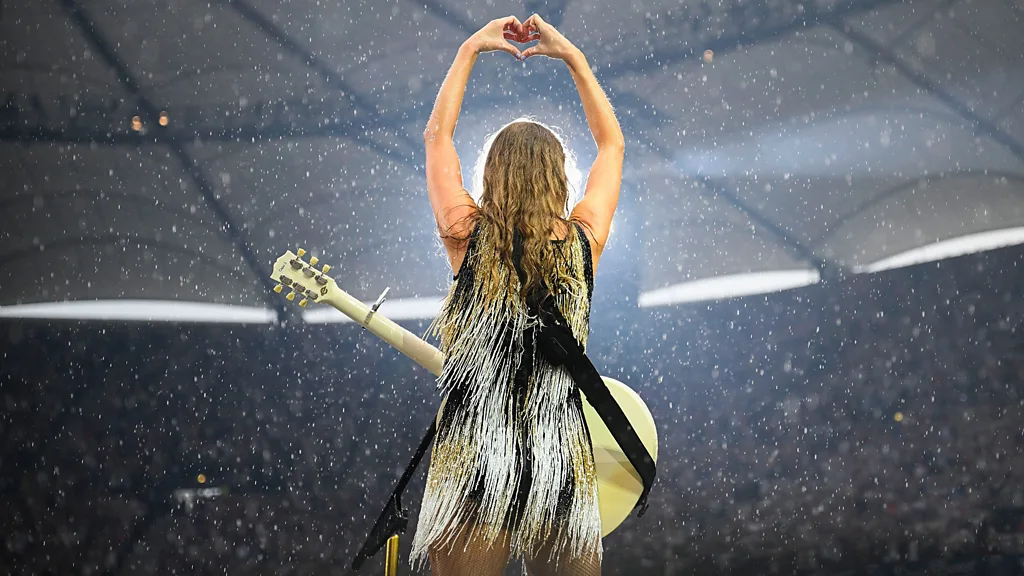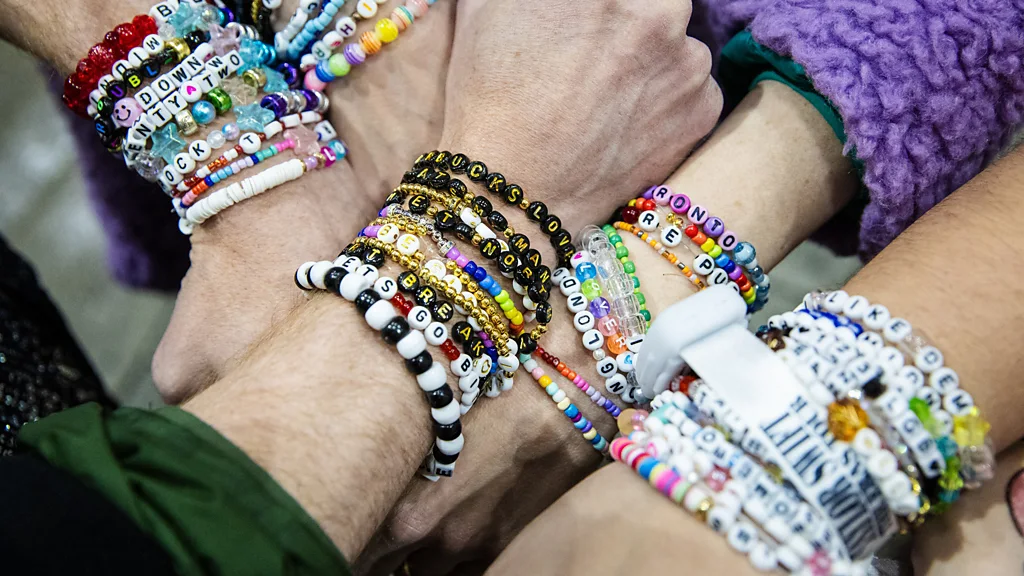
Taylor Swift's Eras Tour hailed as a "cultural juggernaut" for its unparalleled scale and personal connection, concludes this week. Along its journey, it has become the defining live event of our era—one that holds even deeper significance for countless fans.
This weekend, after 20 months, 149 shows, a record-breaking concert film, and millions of friendship bracelet exchanges, Taylor Swift's Eras Tour concludes its remarkable journey in Vancouver, Canada.
More than just a live concert, Taylor Swift's Eras Tour has been a cultural phenomenon, sweeping through 53 cities across five continents. It has dominated headlines, stimulated national economies (and craft markets), triggered mini-earthquakes, and shattered countless records—including becoming the highest-grossing tour of all time, with projections exceeding $2 billion (£1.6 billion), excluding merchandise sales. Since launching the tour in March 2023, Swift has released three albums (re-recordings of Speak Now and 1989, along with The Tortured Poets Department), earned her fourth Album of the Year Grammy—becoming the first artist to do so—and embarked on a widely publicized relationship with NFL star Travis Kelce, who even made an appearance during the tour. Reflecting on the journey, Swift described its conclusion as "the closing of the most extraordinary chapter of my life so far."
The monumental scale and cultural impact of Taylor Swift's Eras Tour are impossible to ignore, from record-breaking attendance figures to its epic 3.5-hour setlist. Over nearly two years, it has evolved into a phenomenon unto itself—even if you didn’t attend, you’ve likely seen clips of Prince William or Tom Cruise dancing at the show, or heard about world leaders lobbying for a stop in their country to boost their economies. While we live in an age of blockbuster live events, nothing has come close to matching the magnitude of this tour. It’s hard to imagine how anyone, even Swift herself, could surpass it anytime soon.
While the sheer scale of Taylor Swift's Eras Tour was extraordinary, its true magic lay in its surprising sense of intimacy. Attending felt less like paying homage to a global megastar and more like participating in a glittering, communal celebration. Earlier this year, Variety aptly named Swift "the world's greatest community organizer."
Relatability has always been Taylor Swift's hallmark. Even as her fame and fortune have skyrocketed—she joined the Forbes World's Billionaires List earlier this year—she's managed to keep fans feeling like she's one of them. This connection begins with her music: universal experiences like heartache, betrayal, loss, revenge, and regret, told with striking specificity. But it extends far beyond her songs to the way she carefully crafts a sense of inclusivity in her live performances.
From the stage design, which stretches two-thirds into the stadium to keep Swift close to the crowd, to her consistent use of "we" and "us" (“We’re about to go on a little adventure together…”), and the LED wristbands that turn the audience into part of the show (a concept pioneered by Coldplay), everything is designed to feel like a collective experience. She first appears amid pastel parachutes, greeted by ecstatic, ear-piercing screams. For a moment, standing on a raised platform, she seems almost celestial. Then, with a smile and a casual “Oh, hi!”—as if greeting old friends—the untouchable suddenly becomes relatable.
The show runs with military precision but includes just enough variation to make each performance feel unique. During her acoustic set, Swift never repeats the same combination of surprise songs or deep-cut mashups. She greets crowds in local languages, including Welsh, Portuguese, Spanish, and French. In every city, her backing dancer Kameron Saunders delivers a locally tailored quip during We Are Never Ever Getting Back Together (in Ireland: “the neck of ye,” London: “up yours,” Edinburgh: “bolt ya rocket”).
In May, she added a new segment to the setlist, featuring tracks from this year’s The Tortured Poet's Department, including the hit single I Can Do It with a Broken Heart, a song inspired by performing on the Eras Tour while navigating heartbreak.
A 'communal belonging'
The Eras Tour has been a rolling stone, gathering not moss but new traditions and deeper meaning along the way. Fans have created their own rituals that have become integral to the show—extended, ecstatic applause after Champagne Problems (which Swift pretends to be surprised by every time), chanting Kendrick Lamar’s lines from his remix of Bad Blood, and of course, the friendship bracelets—sparked by a lyric in her song You’re On Your Own Kid. In every stadium, thousands of forearms are weighed down by stacks of hand-crafted bracelets that are traded with strangers, security guards, and even, at one London show, Sir Paul McCartney. For fans, these moments are as much a part of the experience as the music itself.
Another fan custom involves screaming “take us to church” as Swift hits the high notes of Don’t Blame Me from the Reputation era. Philosopher Simon Critchley, whose book On Mysticism explores the transcendent power of music and art, suggests that for many fans, they are already in a form of worship. "I think her fans are going to church, or the closest they can get to church," he told the BBC. Critchley, who views music as "maybe the last bastion of something like religious transcendence," believes Swift is fulfilling a metaphysical need for her fans. "They don’t think she’s God, but to them, she’s someone very special, and she mediates a form of communal belonging that is lacking in other areas of their lives."
The Eras Tour has drawn people in droves—not just hardcore Swifties, but anyone unwilling to miss out on an era-defining cultural phenomenon. Tickets were notoriously difficult to secure, with some fans paying thousands on resale sites. Many traveled across the globe to attend, while those unable to get inside gathered outside stadiums. In Munich, 40,000 ticketless fans assembled on a nearby hill—not just to be closer to their idol, but to one another. Each night, hundreds of thousands of fans tuned in to grainy livestreams of the shows online. When Swift’s Vienna concerts were canceled due to a terrorist threat, fans still united in the streets to sing her songs and trade friendship bracelets.
“This is devotional practice, and the fans are making pilgrimages,” says philosopher Simon Critchley. “It’s almost as if the difficulty is part of the experience. Think of medieval pilgrimages—they were really hard.”
In the post-pandemic world, live shows have seen unprecedented demand as people crave in-person experiences again. “That sense of disconnection from each other during Covid, the distrust that came with it, and the fact that many of us became like monks and nuns, reflecting on what we were missing... there’s an intense, metaphysical need to feel together with other people,” explains Critchley.
Taylor Swift herself acknowledges this sense of connection. In the foreword to her newly released Eras Tour book, she writes: “We do it because people need an escape from how brutal life can be, and it is the honor of a lifetime to be that for them, if only for a night. And although we are on our own in this big, scary life, somehow it doesn’t feel that way when we’re singing the same words as 80,000 other people wearing glittery face paint.”
She’s not the only artist embracing the communal aspect of live performances. Beyoncé, in explaining her decision to prioritize live shows over music videos, told GQ: “The fans from all over the world became the visual. We all got the visual on tour.” Similarly, Charli XCX’s Brat Tour feels more like a warehouse rave, while Chappell Roan adds themes to her concerts, encouraging fans to dress accordingly. “I’m big on crowd participation,” Roan told Nylon.
Dressing for the occasion has become a major part of the live show experience, with many Swifties attending as their favorite "Era." As ticket prices soar, fans are increasingly determined to make the most of these events, transforming them into vibrant celebrations of music and community.










0 Comments